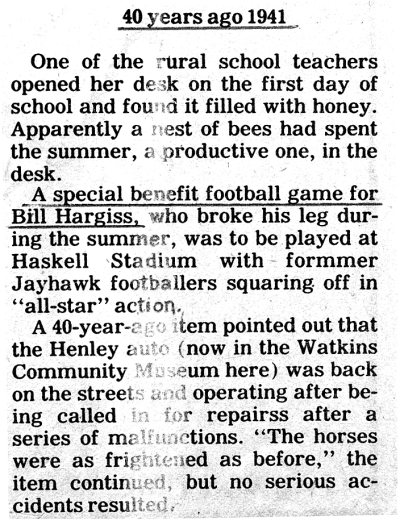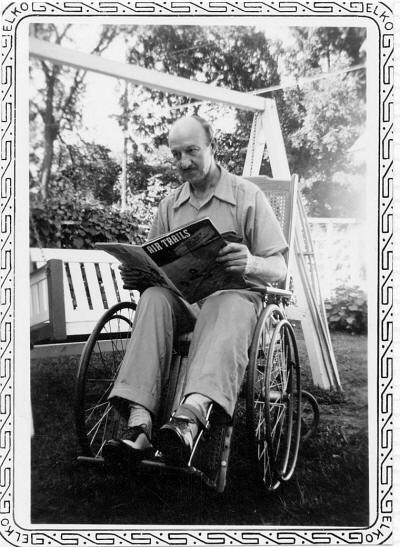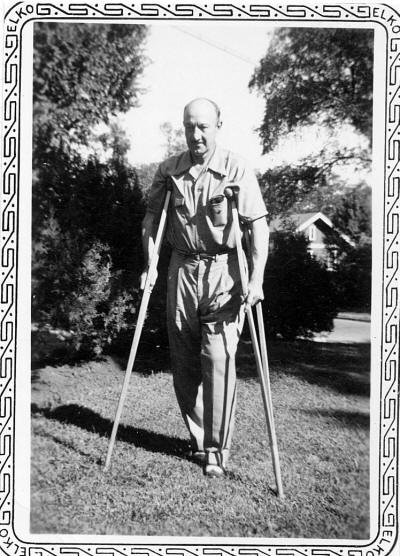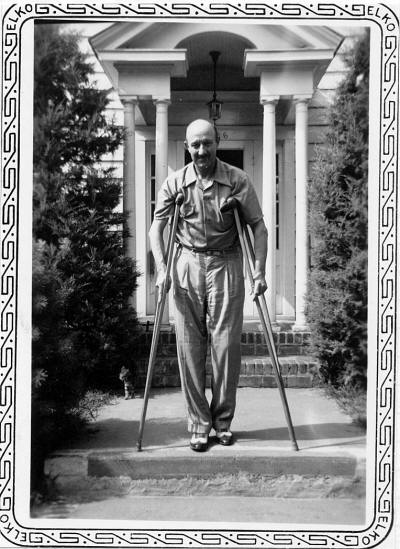|
|
Bill Hargiss' Coronado Pageant Accident, 1941
Note by Genevieve Hargiss:
The Coronado Entrada pageant was a community production held in the KU stadium, with Bill playing the part of Coronado. During the final rehearsal he rode a horse up a ramp and onto a platform that was several feet above the ground. Something startled the horse, and it reared up on its hind legs and fell backward off the platform, crushing Bill underneath its body. The horse was a handsome and expensive animal that had been borrowed for the occasion, but it was injured so badly that the owner asked to have it shot immediately. Bill was also hurt badly, suffering a shattered leg, broken ribs, and internal injuries. We were told that as he was carried off the field on a stretcher he waved to the crowd and called, "Coronado rides again!"--the theme of the pageant. The doctors at the Lawrence hospital advised amputation of his leg, but Bill, supported by Vera, refused to give the necessary permission despite dire predictions about what might happen. An orthopedic specialist in Kansas City, whom Bill knew, was asked to come to Lawrence for a consultation. He recommended trying to save the leg by trimming the bones and pinning them together. One of the pins was a big one, inserted all the way through the knee from side to side. Instead of being put in a cast, the entire leg was suspended in a steel frame from the hip almost to the floor, so that no weight would be put on the leg during the healing process. When Bill came home six weeks later, he was determined to be able, eventually, to walk without crutches or a cane and to flex his frozen knee joint. He did both, but it required persistent and painful exercise over a long period of time.
His son Clarke, who was in Lawrence at the time, adds to the story
as follows:
"I clearly remember Pops [as his family called him] saying
that a mule caused the problem. He said someone started to bring a mule up the ramp
and he yelled "Get the mule off," but it was too late. The doctor who saved his
leg was Dr. Francisco. I remember meeting him once. I visited Pops often while he
was in the hospital, and he never appeared discouraged. My friend, Bill Stanton,
was a delivery boy for the Kansas City Star in that part of Lawrence and brought
Pops a free paper every day. When he came home he couldn't straighten his
leg. Every day, for several months, he would sit on the floor and have me stand
on his leg, with one foot just above the knee and the other just below, and then
jump up and down. It was very painful, but he never complained."
His daughter Shirley also adds:
"This was a big deal. A state production with a cast of two thousand.
I rehearsed his dialog with him. The Wichita production had another Coronado
who came to the Lawrence production to fill in after Dad was hurt (at the dress
rehearsal). He was shorter and not as dashing in the gorgeous costume.
It ran for several nights in the stadium. When Dr. Francisco asked Dad why he wouldn't
agree to the amputation, Dad said, "Because I'll need it". The Dr. didn't
think it could be saved but he said privately to the staff, "Don't argue with him.
We can take it off later." He didn't save Dad's leg - Dad did.
(And he played his age in golf at 80.) He had the big room right off the lobby
and there was a steady stream of visitors who snacked on all the goodies that the
town sent him. He played a joke on the nurses. When they were taking
his temperature and not looking he would stick it in ice water and they were so
excited they ran out to get another thermometer. Then he would heat it up
with a match and off they would run off again. I took the bus out to see him
every afternoon. The paper ran a chart on the front page every day showing
the fund that was going up with contributions to pay his hospital bills."
A limerick appeared in the local paper:
There once was a cowboy named Billy
Who thrilled all the frills on the hilly,
But then he fell down
And upset the whole town,
Now a bedpan rough rider is Billy.
The pageant was in June. In December
of the same year (1941) the United States entered into World War II. Bill coached
track the following spring, but the season was a diminished one in the number of
track and field meets held and also in the number of athletes still in school. College
men were rapidly enlisting or being drafted for military training. Bill was 54 years
old, but he wanted very much to participate in the war effort somehow. (He had registered
for the draft in 1917, but because he was the sole support of a wife and two small
children, he was given a temporary deferment. World War I was over before he was
called.)
Later in the year (1942) Bill accepted an invitation to
go to Brooklyn and be the assistant coach and head scout for the Dodgers, a professional
football team. As much as for any other reason, he did this hoping to make some
contacts that would help him get into military service. It did not look like this
was happening, so the next year when he was offered a position with Pratt and Whitney
Aircraft in Kansas City, he came home.
How's Bill Hargiss?
One of the most frequently asked questions coming to University
staff members through the summer has been, "How's Bill Hargiss?" The answer is,
"Coming along slowly but surely." Taken to the hospital June 3 with his left leg
broken in several places when his horse fell from an elevated stage in a rehearsal
for the Coronado show, Coach Hargiss got home after six weeks' confinement. He walks
with crutches. Exercises to get the injured member back into working condition occupy
much of his time.
Before he could move about, the versatile coach took to
painting again, an art in which he showed considerable talent in former years. His
daughter, Genevieve, fa'33, g'37, of Tempe, Ariz., sent him a special set of dry
Frescol paints, and "the Bald Eagle" has been getting some fine results.
Lawrence business men and other friends raised a fund of
nearly $1,200 to pay most of Bill's tremendous expenses in connection with the accident.
In the meantime, he wonders what kind of a track team he will be able to assemble
this year.



